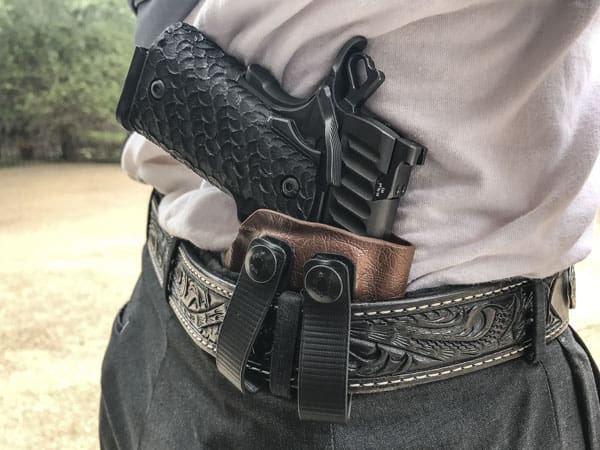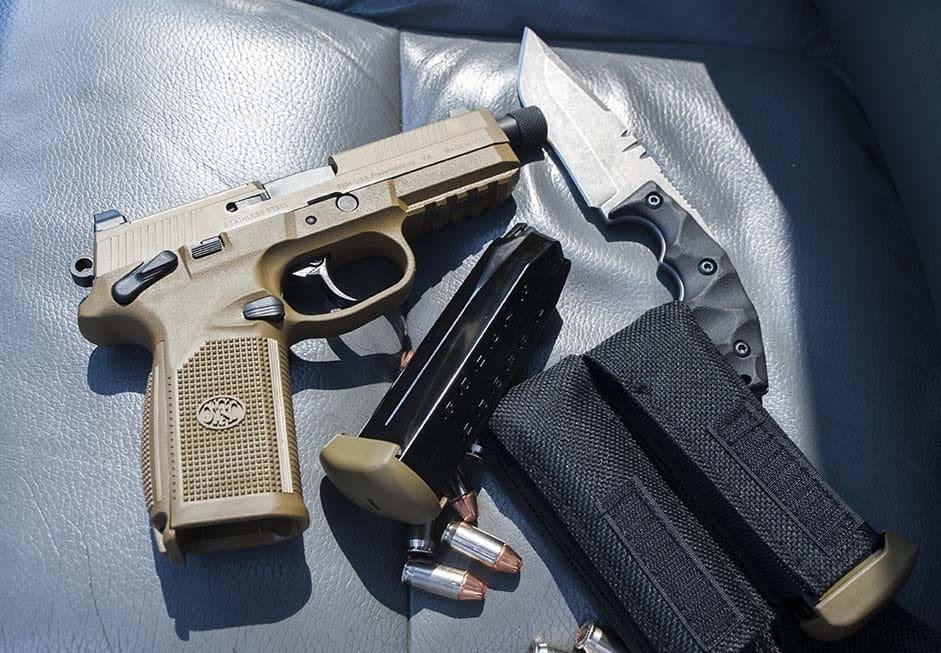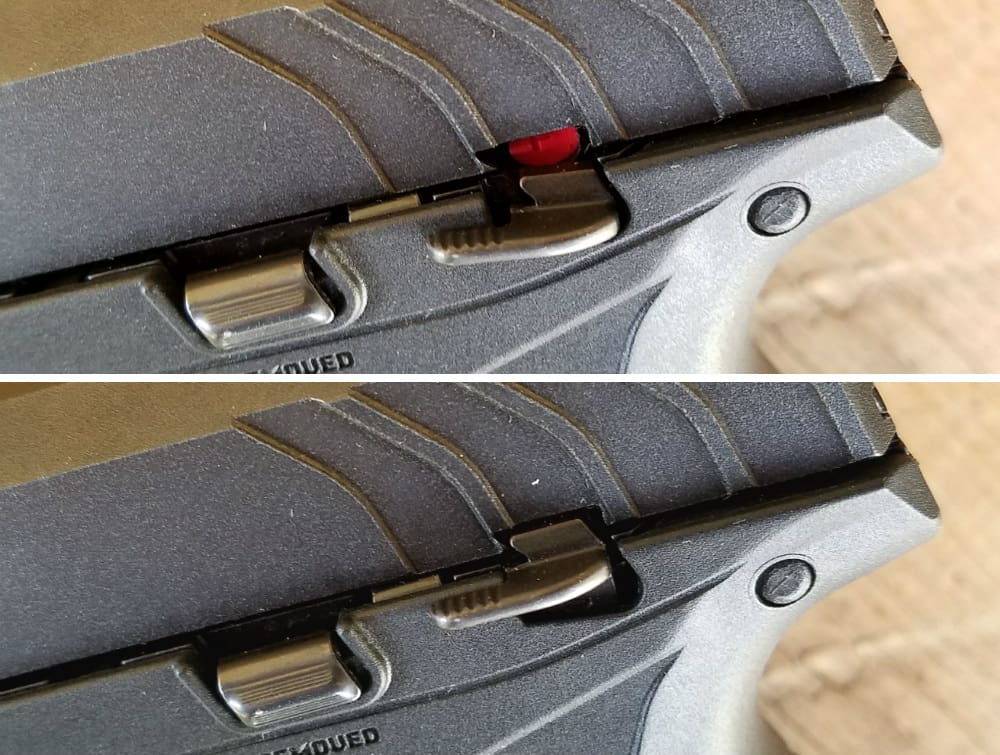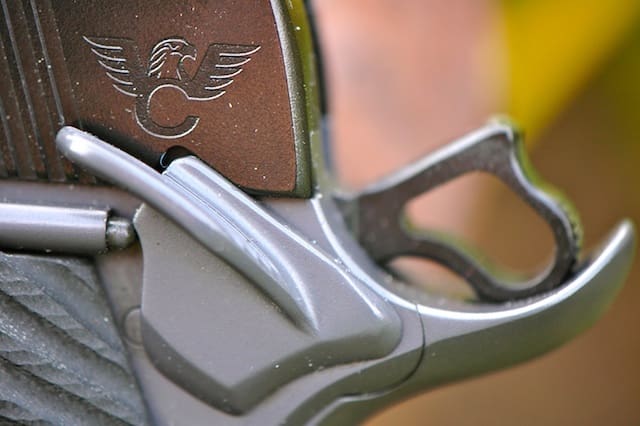By John Sprague
There is a large contingent of gun users — many of them here — who are adamant that the only safety a gun needs is some self-control over the use of your booger hook. I would like to present an alternative view.
Manual safeties are not the enemy of readiness that some would have you believe. We can probably agree that the highest state of readiness a gun owner can achieve is to have a gun in each hand pointing at anyone who might possibly pose a threat to your or your family. Obviously, that’s not terribly safe or practical. So we have to start making a few concessions to bring our state of readiness into balance with practicality and safety.
Instead of lasering everyone who comes near us, we could leave one gun in the safe and carry the other in a low-ready position with our pistol pointing downward at a 45° angle. Since that’s only a little less practical way to ward off an attack, we can then practice transitioning from the low-ready to on-target.
But if walking around with a pistol in low-ready all day doesn’t work for you — and I’m fairly sure it won’t — you might consider carrying your firearm (and I’m just blue-skying here) in a leather or thermoplastic holder thingy that attaches conveniently to your hip.

Now we’ve managed to increase the safety factor dramatically. At the same time, though, we’ve sacrificed a fair amount of readiness. So, as always, it comes back to training.
That means you’ll have to practice drawing your gun and transitioning to your target. You can carry this logic all the way to keeping your pistol secured with a gun lock, in a case, in the trunk of your car with the ammo in the glove box. The safety factor of this condition is, naturally, through the roof. But your state of readiness and the practicality of being able to defend yourself will have disappeared almost completely.
Somewhere in the middle lies your particular personal state of safety/readiness balance. Everyone needs to find their own acceptable equilibrium between safety and readiness. For some, a manual safety is one tick too far toward the safety side and away from readiness.

For me, though, it’s the perfect compromise. I practice for my state of carry. I use a holster. I use a gun with a grip safety. I use a gun with a manual safety, too. I practice and train for this carry condition so that if and when I have to use my gun to defend myself, drawing, disengaging the safety and bringing the gun to bear are part of one continuous motion.
I once found myself in a position during which I had to draw my weapon in a high stress, adrenaline-dump situation. When I pulled my piece, I flipped off the safety automatically. Why? Because I had trained myself to lift my conceal garment, establish a proper grip, draw the gun, flick off the safety and bring the sights up to the target – all in one fluid motion.

Lo and behold, what I had trained for is exactly what happened when the time came. Some say that in a high stress situation you’ll become all thumbs and “forget” to flip off the safety. I beg to differ. I believe that what you train for, what you rehearse, what you drill into muscle memory is what will happen when it’s needed most.
If the manual safety tips your particular scale too far to one side then by all means, don’t use one. For me, the benefits and peace of mind a safety provides are perfectly balanced with the incremental reduction in readiness.
Whatever you do, find your own balance.





I still carry a Colt Commander and have a CZ75 and I’m not a fudd.
So you say. 🙂
I resemble that remark!
I am partial to Smith and Wesson Third generation pistols with manual safety and a magazine disconnect safety. Disengaging the safety while tapping the base of the magazine to ensure that it is seated properly (advisable for a plastic fantastic double action only pistol such as a Glock) occurs automatically as I draw my pistol. Thumbing the hammer to cock it occurs if time allows because shooting single action is more accurate than shooting double action.
Oh great, yet another opportunity for daican to have one of his ignorant copy-n-paste ‘orgasms’ of word salad screeds.
I’m pretty sure daican doesn’t believe most of the things it writes. No one with a functioning nervous system would.
I’ve had gats with manuel safeties & none. I really have no preference. Except my scary rifle. The safety on my shotgun is NOT reliable…
How is your shotgun safety not reliable?
Really? They ain’t drop safe. Pretty well known…
Not saying you are wrong but never heard of it on my end. What type of shotgun and what is the event chain that results in the failure (genuinely interested)
It’s very situational, and very dependent on the individual. I have a variety of firearms, with a variety of safeties, etc. But for carry, my first was a glock, and for carry guns it makes more sense for me to stick to guns that ‘work like a glock’ instead of re-training decades of accumulated muscle memory. At the range, variety is the spice of life, and small mistakes don’t matter much unless it’s a competition.
“But for carry, my first was a glock, and for carry guns it makes more sense for me to stick to guns that ‘work like a glock’ instead of re-training decades of accumulated muscle memory.”
There’s little re-training when you carry a semi-auto with a de-cocker. Like the Glock, when ‘one is in the pipe’, it’s ready-to-go, albeit with a heavier trigger pull on the first round. But, it’s light-years safer to carry appendix.
I really, really, REALLY wish Glock had an option to carry with the first round completely de-cocked, but that’s not gonna be happening. For me, I’m most comfortable with a hammer-fired gun with a DAO first-round trigger pull, and that’s a semi-auto with a de-cocker, especially carried appendix. I’m just not comfortable carrying a Glock appendix when it’s two-thirds ready to party…
While my daily edc is a Shield 9mm with a manual safety, that’s been worked to make it easier to operate. I often carry a Ruger P89DC. It was one of my first semi auto handguns and have always considered it the safest possible configuration for a carry firearm. Getting used to the heavy trigger is more mental than physical. Once you spend time training with it. It becomes 2nd nature and I don’t even think about it being a heavy trigger.
It’s not a problem for me, I _far_ prefer the heavy first trigger pull than the risk of perforating a groin artery… 🙂
all my guns have safeties. I dry fire practice daily no problem. no shot timer difference with it without a safety.
I’ve carried a SA auto all of my adult life. Never thought about wiping the safety off. It just happened. Never thought about putting it back on. That just happened too. Never used a decocking lever for a safety. Never forgot which action type I had in my hands under stress. Training. Under stress if you scan.
Now for some sad news and a great loss to the firearms community.
Jim Scoutten, Shooting USA legend and OSG TV Personality, Di – Firearms News
https://www.firearmsnews.com/editorial/jim-scoutten-passing/478513
Posted this last week with nary a comment. Thanks for the mention…
I’ve been carrying without a safety for many years. No problems. Plus, safeties suck. Just like with anything else, training is the best solution, but some people couldn’t be bothered.
It doesn’t get much safer than a DAO revolver or DAO hammer fired semiautomatic pistol. There’s no such thing as an “Accidental Discharge” with them.
Rick, no such thing as an AD with a DAO? Yes there is. Stupid will find a way.
What category does a DAO revolver fall into?
“What category does a DAO revolver fall into?”
Double-action always.
(Breaking my arm patting myself on the back vigorously… 😉 )
The part that is so confusing is in the thinking of the person carrying.
Those that demand a safety but carry a revolver. Then the ones that refuse the safety claiming it will slow them down but wont carry with one in the chamber.
I’m asking why it should matter so much to someone that goes to the range so rarely that they never get in enough practice to do groups on paper that don’t look more like bird shot at 50 yards.
Carry what you want to but if you can’t hit the broad side of a barn then that manual safety will never mean much.
Has there ever been a real world proven case where the use of a manual safety has resulted in harm to the user ?
Has the operation of the
manual safety ever slowed one down giving ones oponent the advantage ?
On the other hand are their any cases where shots were fired inadvertantly because one pulled up on the trigger as they drew ?
Why is it all long arms have safeties but some pistols do not ?
The internet is full of justification for no manual safety guns like glocks, with many saying the holster is the safety or its your training that suffices or its even its your finger. Some used the justification that revolvers lack manual safeties so semi-autos dont need them. I think all of this reasoning is partially true, but does not preclude the fact that without a manual safety the gun can be fired with a trigger press only, and by an untrained person like a child. The manual safety, acting as an extra interlock provides that hold point of the mind so that the the order of firing sequence includes a hold point ( safety disingage).
My initial introduction to semi-auto handguns was the 1911 of which I carried for nearly 20 yrs. When I turned to plastic pistols I chose the M&P with a manual safety and ultimately an FNX. The use a manual safety is pure muscle memory to me, and I will always carry a pistol with one.
“Suum cuique”
Excellent questions. To your second, I’d add the corollary, “If you think that operation of a manual safety would slow you down, explain why Open / Unlimited competitive divisions are dominated by manual-safety pistols?”
“Has there ever been a real world proven case where the use of a manual safety has resulted in harm to the user ?”
I suppose if they’re dead as a result of bobble-fingering the safety, they aren’t in a position to report on their own stupidity…
“Has there ever been a real world proven case where the use of a manual safety has resulted in harm to the user?”
I’ve heard the opposite. In a scuffle with the police, the perp was able to grab the cop’s gun. He pointed and tried to shoot. He didn’t flip the safety off first. That gave the cops time to disarm him and take him down.
y’all need to watch this, the whole thing, your internet searches alone can bring the ATF to your door…
Precursor to ATF Raids? You. Bet. ATF Agents Put You on Notice, Government Tracks Search History? Is the ATF monitoring what you you search for online? On Gunbroker? There is some evidence that the answer may be yes. Check out the video to get the scoop.
Cops of any kind at my door : We want (insert bs reason here)
Me : You got a warrant?
Cop : We can get one.
Me : Well until then get off my lawn and don’t come back.
All family members, even those that don’t live here, know thats the proper response.
That looked to me like to random guys from the neighborhood showing up. Certainly not ATF.
.
Of course “their” monitoring us and not only the gunm guys either. They have to know what everyone is doing for some reason.
Free .giv cell phones. I wonder why my poor old grandma never got a free land line. I suppose its because you have to get a warrant for a wire tap and the phone on a wall cant ping the phone that’s in your friends pocket either.
Facebook Twitter TTAG, Emu online, knives, anything.
Big Brother is watching
My attitude is simply, if you have ever cut yourself in the kitchen with a knife, then a Manuel safety is a good idea, cause bullets hurt more. However, too each their own.
None of my guns have a thumb safety, so I carry on an empty chamber.
Age has a way of changing things, just keep living and time will tell.
Age coupled with other health issues including absent mindedness has convinced me that For Me carrying on an empty chamber is best for me.
One size does not fit all.
Didn’t see it. Jim Scoutten. That’s unfortunate. My son was over a week or two ago. Scoutten was on. John commented that he remembered him from years ago. Tell you what. When Scoutten was on set that was one hell of a rifle battery on the wall behind him.
Safety first.
It isn’t as simple as a manual safety is good or bad. All safeties are not created equal. Some are good for defensive use, some aren’t. You don’t want one that could easily flip off during recoil. Some are made such that it’s uncomfortable to hold your thumb over it while firing.
Manual safeties are gun and user dependent.
No problem manipulating one on a 1911; in fact proper technique has you resting your thumb on it.
Big problem operating the ones on a CZ Tactical Sport, for example.
And the ones on the SLIDE (for example, Beretta) just suck.
I completely agree about both the 1911 and the Beretta, but I’m intrigued by your CZ comment. I have a Witness Hunter (Italian knockoff CZ) and it has a perfectly ergonomic, can’t-miss “gas pedal” in 1911 position and orientation. I’ve only briefly handled a CZ Tactical Sport (years ago), but figured it was the same.
I agree with your (and Dude’s) overall points, though, and I’d just add there’s no real excuse in 2023. When DA autos were new (30s), the complexity of integrating decocking and FP block in one made it necessary to mount the lever on the slide – and the fact that it was meant to be decocked and then carried like a revolver (with the heavy trigger as the only safety) made the ergos less important. They solved that riddle in the 70s.
Optimum ergos for every human with functional thumbs were figured out a long time ago, and then passed out of patent protection. Manufacturers get to copy off the paper of the guys who got 100% on the test, and when they choose safeties that suck (often, unnecessarily, in the name of concealability) it represents a conscious choice for failure.
Well said. I generally carry Condition 3 now that grandkids fill the home. Although some say that this puts one at risk, the Israeli military finds it appropriate. And its appropriate for me.
BUT. When outside the home and I see or sense trouble ahead I go to Condition 1.
Only once in my 50 yrs of carry, at age 66 have I needed to draw, rack and aim on an advancing man. The threat decided this old man wasnt worth it.
Comments are closed.